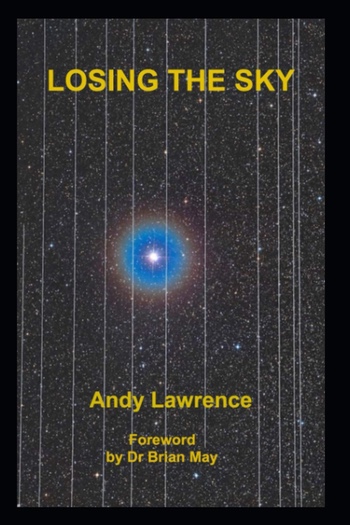Review: Losing the Skyby Jeff Foust
|
| A satellite constellation can be “a beautiful and visionary scheme,” he writes, but also “it is hard to imagine anything better designed to foul up the night sky.” |
The bad news, though, is that the VisorSats aren’t quite yet at the goal of magnitude 7 that astronomers set to minimize interference with the upcoming Vera Rubin Observatory, whose wide field of view and sensitive detectors were particularly susceptible to bright satellites. Worse, there remain concerns about other satellite constellations either because they are in higher orbits, like OneWeb, and thus visible for longer each night, or because they might be unable or unwilling to reduce their brightness. Richard Green of the University of Arizona, at a policy town hall session during the conference, said he was particularly concerned with proposed satellites by mobile satellite telephony company AST SpaceMobile, whose large antennas may make them impossible to reach the magnitude 7 goal even with mitigation measures.
So, what are astronomers to do about the threat posed by megaconstellations? That’s the question posed, but not firmly answered, in Losing the Sky by Andy Lawrence, an astronomer at the University of Edinburgh. Lawrence is hosting a public forum about this subject on Tuesday at 2:30 pm EDT with a wide-ranging set of panels will discuss their concerns about megaconstellations. (The event includes OneWeb and Viasat, a company that has battled SpaceX’s Starlink in FCC proceedings, but not SpaceX or other companies developing megaconstellations.)
In the book’s introduction, he states that he was prompted to write the book based on worries voiced by fellow astronomers about the threat posed by Starlink and other satellites. He hoped this would be a polemical book of sorts, a cry to public action like Rachel Carson’s Silent Spring was for the environmental movement nearly six decades ago.
Losing the Sky is not a Silent Spring for space environmentalism, though. He describes how LEO constellations work and how they can interfere with optical astronomy because of their brightness from reflected sunlight, as well as with radio astronomy because of their downlinks. A satellite constellation can be “a beautiful and visionary scheme,” he writes, but also “it is hard to imagine anything better designed to foul up the night sky.” He is skeptical of mitigation schemes, like VisorSats, arguing that they may help to some degree, “although probably not enough.”
However, he acknowledges that such constellations can have benefits, providing broadband to those people who have few, if any options for access today. He compares it at one point in the book to a Christmas market in his hometown of Edinburgh, where a company hired to run the market closed off public access to a park for months and left behind a mess. Yet, he states, he and many other residents shopped at and otherwise enjoyed the market. Can you have it both ways?
He suggests the solution is some kind of international regulation, but admits that doing so will take time, and anything that is binding will take even longer. (It took, for example, the better part of a decade for the UN’s Committee on the Peaceful Uses of Outer Space to adopt a set of non-binding guidelines for long-term space sustainability.) “Meanwhile, we absolutely should publicly protest, engage and negotiate, and possibly litigate,” he concludes.
| If astronomers wait for the diplomats to act, the sky may well be lost—at least for them. |
But does the public really care about megaconstellations interfering with astronomy? Lawrence describes the “loss of the sky” as “the final straw” for the public in broader concerns about the environment. But, despite visions offered by some astronomers of satellites crisscrossing the night sky, those satellites will be invisible to people in light-polluted cities and suburbs. The VisorSat versions of Starlink, in fact, are too dim to see with the naked eye in all but the best viewing conditions once in their final orbits. (They are more readily visible during their orbit-raising process, an issue SpaceX has also been trying to address.) They certainly pose a hazard to both professional and amateur astronomers, but their concerns may not be shared by the wider public.
At the end of book, Lawrence points readers to a petition demanding that the FCC withdraw licenses for Starlink and other megaconstellations. That petition has attracted only about 17,400 signatures since November 2019 (16,787 when Lawrence wrote that section of the book, published early this year.) That’s… not a lot. By contrast, an odd petition demanding that Washington’s Reagan National Airport be renamed after a teenage pop star has received more than 73,000 signatures since this spring. The public is more interested in pop stars than celestial stars.
Fortunately, public interest isn’t required to try and solve this problem. It can be included into broader discussions about space sustainability that include ways to mitigate the growth of orbital debris and clean up existing debris. Given the glacial pace of international proceedings, engagement with companies, like what astronomers have been doing with SpaceX since 2019 that led to things like VisorSat, offers the best path to near-term solutions to solving the problem. If astronomers wait for the diplomats to act, the sky may well be lost—at least for them.
Note: we are using a new commenting system, which may require you to create a new account.
